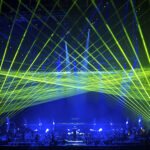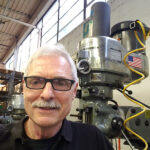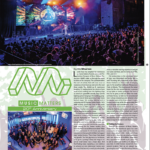Pyro Pioneer is More than a Flash in the Pan
Along with the opening of its new production facility in rural Missouri, its first manufacturing hub outside of the U.K., Le Maitre is celebrating a milestone this year — the 40th year since its humble beginnings in 1977.
The new pyrotechnics factory makes a number of the company’s large-scale effects, including its 150-foot and 200-foot Comets (single bright stars projected into the air), flames and gun flash. Having a facility in the U.S. allows Le Maitre to provide faster response to customer demand, a hallmark of the company’s operating philosophy.

The Early Days
The demand for pyro effects was not always this robust, says Rick Wilson, who founded Le Maitre with Harold Berlinski and Martin Blake in 1977. In fact, there was no effective pyro business back then. “Rank Strand (remember them?) used to sell pots of 75-gram flash powder and cardboard maroons for making large bangs,” he says. “In the early ‘70s, some bands — in particular Stray (Del Bromham and company) — would use flash powder across the front of the stage, loaded into a metal roof gutter. The ignition system was very sophisticated, consisting of a roadie with a Zippo.”
Wilson remembers the moment that changed everything. “Martin, who was a lighting designer from a company called Chrystalium Lighting, remarked to me when we witnessed this enormous effect, ‘There must be a better way of doing this.’”

Spurred by this experience, Blake came up with the concept of encapsulated pyrotechnics, “with a two-pin plug-in system and a safe electrical two-way controller, which he had the foresight to patent,” says Wilson. Le Maitre attended its first trade show, Discotheque ‘77, at Bloomsbury Centre in London, England, and introduced its Pyroflash System using Blake’s technology.
“When the partnership was formed, Martin also brought to the table his fabled Peasouper fog machine, which in those days was made with a fiberglass shell together with a vacuum-formed mirror ball (which was soon dropped in favor of handmade glass tiles),” Wilson says. “The products at the time had no peers.”
It took almost no time for the entertainment industry to recognize this critical difference in product quality and safety. Le Maitre’s sales expanded beyond England into Europe. “Germany became a very large customer,” Wilson says. “Europe was influential in pushing us into expanding the range of special effects and moving into lighting.”

Getting the Bugs out of Fog
Billowing fog and haze can shroud a stage in mystery, aid a surprise entrance, and make the air itself dance with color when a clever lighting designer uses it wisely. Achieving these effects without schlepping blocks of dry ice into a theatre was a tricky business before the 1970s, Wilson says — and even then, producing haze had major drawbacks.
“In the late ‘70s, there were smoke machines available,” he explains, “but these were all machines adapted from the insect control market.” So the same machines used to spread DDT and other noxious gases over farmers’ fields found their way backstage — but these were not created to run quietly or to provide targeted, controlled swells.
“Again, Martin Blake looked at what was available on the market and discounted all the current technology for producing smoke from an electrically driven machine,” says Wilson. “He came up with a brilliant new concept, and it hit the market as the Cloud Nine, the first commercially developed smoke machine specifically for the entertainment industry.”
Cloud Nine became an industry mainstay, but Blake did not stop there. “Martin excelled himself with a completely revolutionary way of manufacturing the heating chamber for smoke machines, with a two-piece aluminum system, which metamorphosed into the Mini Mist (which is still in production). We then brought out the Smoke Processor, which used the Mini Mist Block, only double in size, making it the most powerful smoke machine in the entertainment industry.”
When technical wizard Dave Roffey joined the company, he improved on the Smoke Processor. “It eventually became the first digital machine, the predecessor of the world-beating G300,” Wilson says. “The G300 also saw a new patent in heating chamber technology, known as the Genesis Patent.”
Roffey also addressed the issues of using chemicals in haze machines — which, while non-toxic, could aggravate respiratory issues for people onstage and in the audience. “Dave came up with new patents for our unique range of haze machines, which use a sugar-based haze, getting away completely from glycol-based units,” Wilson says.
Looking Back, Looking Forward
Since those early days, Le Maitre’s factory in Peterborough, England, has gone from producing just two effects — Theatrical Flash and Silver Star — to literally thousands of different products.
Karen Cornacchia, Le Maitre’s joint manager, heads the events arm of the business. “We have several new products we’re about to launch, and one of them may well revolutionize how pyro is rigged on future shows,” she says. “The investment made in plant and high quality personnel has made a huge difference to how the company is moving forward.”
Custom work has become an important part of the business, with Le Maitre’s research and development department creating bespoke products for specific shows, and changing or modifying products to achieve unique effects. “This has really helped Le Maitre to significantly increase our market share, and has allowed us to become a one-stop shop for customers who want much more than just boxes of pyro,” Cornacchia says. “We’re often asked to manage the logistics of an entire tour — arranging all the permitting for tours, contracting with our locals to get the pyro and special FX licensed for the shows, sending local techs, organizing the gas for shows, liaising with promoters, sending all the special FX to our dealer and having it delivered on site across the various countries in time for the shows.”
Maintaining a global presence means that every employee has a relationship with customers, taking calls and answering questions at any time of the day or night. “Rarely is there a client in the world who can’t reach one of our staff, making our response times exceptional,” Cornacchia says.
From a booth at a 1977 trade show to a company with customers in nearly every country on Earth, Le Maitre has turned the flash, sparkle and pop of pyrotechnics into a global phenomenon.
For more information, visit www.lemaitreusa.com.


